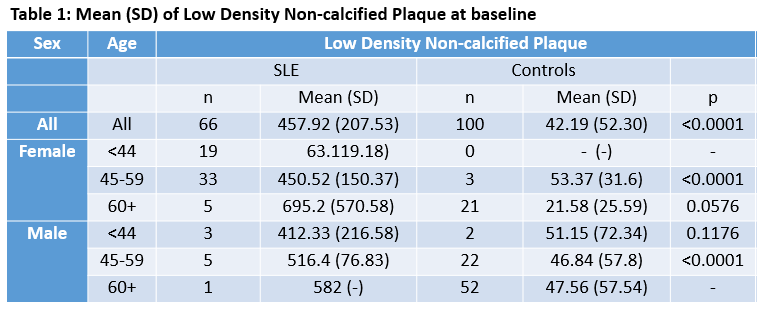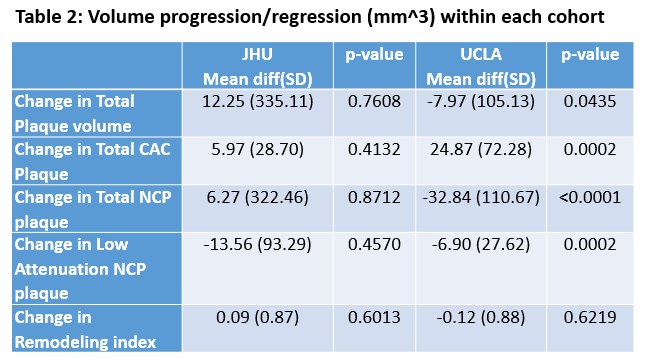Session Information
Session Type: Poster Session (Monday)
Session Time: 9:00AM-11:00AM
Background/Purpose: The presence of low attenuation noncalcified plaque (< 30 Haunsfield units) is one of the most characteristic vessel changes in unstable coronary plaques. Low-attenuation noncalcified plaques (< 30 Haunsfield Units) contain necrotic cores that are characterized by endothelial dysfunction, oxidative stress, and inflammation. They have been shown to be a better predictor of future cardiovascular events compared to traditional cardiovascular risk factors in the general population. Accelerated atherosclerosis leading to premature coronary artery disease remains the major cause of late death in SLE. We sought to characterize low attenuation noncalcified plaque in patients with systemic lupus erythematosus versus controls.
Methods: A total of 72 patients who met the ACR or SLICC classification criteria for SLE had CT angiogram studies, 30 of which had follow up CT angiograms. A total of 100 healthy controls who had two CT angiograms were included in the study. Coronary plaque area was measured by manual tracing for the difference between the area within the external elastic membrane and the area of the vessel lumen at the site of maximal luminal narrowing as observed on a cross-sectional coronary CT angiography image. A noncalcified plaque was defined as a low-density mass >1 mm2 in size, located within the vessel wall and clearly distinguishable from the contrast-enhanced coronary lumen and the surrounding pericardial tissue. Each noncalcified plaque detected within the vessel wall was evaluated with the minimum CT density. T-test was used to evaluate baseline characteristics between lupus patients and controls. Paired t-test or Wilcoxon signed ranks test were used to compare plaque volume between baseline and follow-up for each cohort. Fisher’s exact test was used to evaluate the association between change in low attenuation NCP and demographic and clinical variables including sex, race, age at baseline, ever smoking (from history file), diabetes, hypertension, hyperlipidemia, obesity, lupus anticoagulant, anticardiolipin, anti-beta 2 glycoprotein, hydroxychloroquine and immunosuppressant use, anti- dsDNA, low C3, low C4, antihypertensive, and statin use.
Results: See Table 1 and Table 2
Conclusion: Women with lupus have a significantly higher burden of low attenuation NCP compared to healthy controls in all age subgroups except in those >60 years of age. A similar trend was seen in men but the number of patients was small. While the NCP and low attenuation NCP burden significantly regressed over time in controls, no significant changes were seen in the plaque burden of lupus patients. Statin use did not affect progression of NCP or low attenuation NCP plaque.
To cite this abstract in AMA style:
Stojan G, Li J, Petri M. High Risk Low Attenuation Non-Calcified Coronary Plaque in Lupus vs. Controls [abstract]. Arthritis Rheumatol. 2019; 71 (suppl 10). https://acrabstracts.org/abstract/high-risk-low-attenuation-non-calcified-coronary-plaque-in-lupus-vs-controls/. Accessed .« Back to 2019 ACR/ARP Annual Meeting
ACR Meeting Abstracts - https://acrabstracts.org/abstract/high-risk-low-attenuation-non-calcified-coronary-plaque-in-lupus-vs-controls/


